Research highlights
My research is focused on plasmas in extreme conditions, where quantum effects can affect the collective plasma dynamics. I combine analytical theory and massively parallel computer simulations to test the concepts relevant for current and future experiments. Some of my works are highlighted below.
Antimatter with a blast
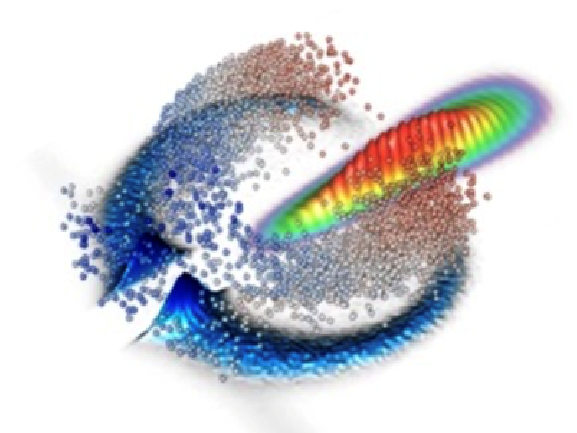
Intense laser interacts with a beam of relativistic electrons. The laser is strong enough to make the electrons emit very energetic photons, that decay into electron-positron pairs. But, more than that, the electrons lose lots of their energy in this interaction – enough that the light pressure of the laser can reflect them like a mirror. Some of the electrons and positrons end up “following” the laser, and if the interaction is long enough, they may even be accelerated together.
Generating abundance of antimatter in laboratory is of great importance both for fundamental science and potential applications. Several scenarios have been envisaged to create plasma clouds (or beams) with approximately equal number of electrons and positrons, dense enough to exhibit collective behaviour. The aim is to study their self-consistent dynamics in conditions that match the ones the pair plasmas experience in space. Electron-positron pairs populate the magnetospheres of pulsars, and are believed to participate in the formation of gamma-ray bursts. It is therefore vital to study the collective processes under extreme intensities, which may play a key role in the global dynamics of pulsar magnetospheres. The new generation of laser facilities is expected to deliver short (10 fs–100 fs) laser pulses with 10–100 PW of peak power. This opens an opportunity to study matter at extreme intensities in the laboratory and provides access to new physics.Apart from laboratory astrophysics, electron-positron pairs have a number of other prospective applications that span from tests of fundamental symmetries in the laws of physics and studies of antimatter gravity to the characterisation of materials. Here we propose a configuration that allows to both create and accelerate an electron-positron beam.The new particles are generated in the laser focus and gain relativistic momentum in the direction of laser propagation. Short focal length is an advantage, as it allows the particles to be ejected from the focal region with a net energy gain in vacuum.Due to the laser defocusing, the trapped particles remain in the laser field only a fraction of a full oscillation cycle. This limits the maximum energy they can attain, but allows for a net energy transfer in vacuum that would otherwise be impossible. This setup produces a quasi-neutral electron-positron flow that can reach multi-GeV energies. A distinguishing aspect of this scheme is to produce at extreme intensities an equal number of electrons and positrons that can be separated from the initial electron beam and can be collected separately.
For more information see M. Vranic et al, “Multi-GeV electron-positron beam generation from laser-electron scattering”, Sci. Rep. 8, 4702 (2018) available here.
Electrons surf the pipe
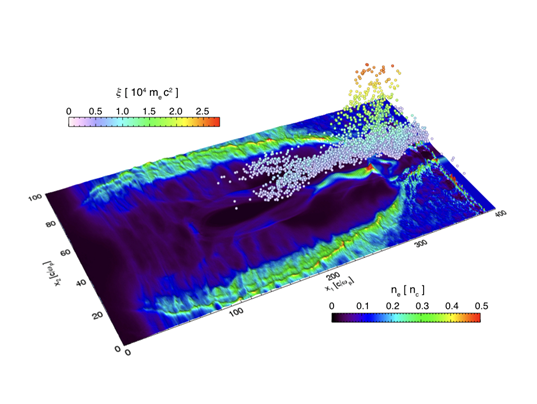
Intense laser propagates through a light-pipe, trapping electrons on its way. The pipe represents a region of low-density plasma within a high-density background (a channel). Due to defocusing, without the channel, the laser could not maintain the high intensity for a long propagation distance. In the light-pipe, trapped electrons almost instantly become relativistic and start co-propagating with the laser. They can accelerate to over 10 GeV in a few millimetres.
The figure shows electron plasma density and the energy of trapped electrons with energy over 1 GeV. The channel wall density is about 30 – 40 % of the critical plasma density (the density opaque for laser light), while in the inside of the channel the plasma density is below 5 % of that value. This structure guides light such that most of the energy travels through the low-density region. Due to the high laser intensity (a0 ~ 600, I ~ 5 x 1023 W/cm2), the interaction between the light and plasma electrons is highly nonlinear. The electrons quiver in the laser field, while at the same time being affected by the collective plasma electromagnetic fields formed within the channel. In addition to the inherent nonlinearity of the interaction, relativistic electrons also emit high-frequency radiation. Sometimes, they convert a considerable fraction of their energy to photons. The electrons then slow down, but they can be re-accelerated by the intense laser field. Curiously, the electron energy loss due to emission (also called “radiation reaction”) helps the electrons to attain multi-GeV energies. This happens because the radiation reaction facilitates efficient trapping of the electrons in the centre of the light pipe, which puts them in ideal conditions for acceleration.
For more information, see M. Vranic et al., Extremely intense laser-based electron acceleration in a plasma channel, Plasma Physics and Controlled Fusion 60, p. 034002 (2018), available here.
The waves that stand their ground
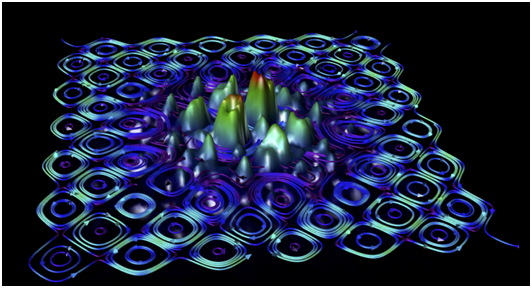
See video >>
This is a 2D standing wave created by two pairs of counter-propagating linearly polarised lasers. One pair is moving in x, and the other in y direction. The loops on the picture represent the electric field lines of the standing wave in the region where all four lasers overlap. The surface shows the density of emerging plasma that is created by a QED cascade in the laser field. When the surface is above the level of the electric field vector plane, the plasma density is superior to the relativistic critical density, and the laser field structure is disturbed by the presence of such plasma.
The possibility to create matter from vacuum has been one of the most exciting predictions of quantum electrodynamics. Schwinger in 1951 assumed that for creating spontaneously an electron-positron pair in vacuum, the field has to be strong enough to perform a work of an electron rest mass over a Compton wavelength. This became a definition of the critical field of quantum electrodynamics, below which the probability of creating electron-positron pairs becomes very small. In a field higher than the Schwinger critical field, a single electron or an energetic photon can seed a QED cascade, an avalanche of repeated pair creation that leads to a production of a very large number of particles. Unfortunately, this could not be tested in the lab so far, because the Schwinger critical field was (and still is) beyond reach of state-of-the-art laser technology. However, there is a way to observe QED cascades with near-future laser technology, even without reaching the Schwinger field. Lasers can accelerate electrons to relativistic energies, and the Lorentz-boosted fields the electrons perceive in their rest frame can be several orders of magnitude higher than in the laboratory. Using clever configurations to maximise this effect, it is possible to reach the Schwinger field in the electron rest frame. One such setup is shown here: a four-laser optical trap is used to create a QED cascade seeded by a small target. The figure shows a standing wave created by the four linearly polarised lasers arranged in two pairs of lasers counter-propagating with each other. One pair is moving in x, and the other in y direction. The loops on the picture represent the electric field structure of the standing wave in the region where all four lasers overlap. The surface shows the density of emerging plasma that is created by a QED cascade in the laser field. When the surface is above the level of the electric field vector plane, the plasma density is superior to the relativistic critical density, and the laser field structure is disturbed by the presence of such plasma.
For more information, see M. Vranic et al, “Electron–positron cascades in multiple-laser optical traps” Plasma Phys. Control. F. 59, 014040 (2017) available here.
Slow down, mister!
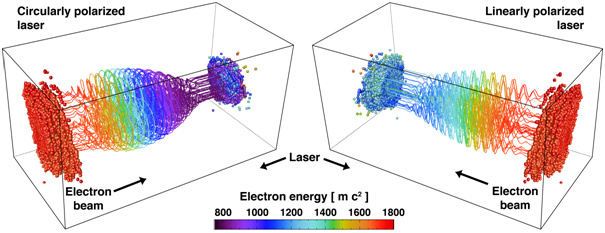
The figure shows electron trajectories in transverse momentum space while colliding head-on with an intense laser. The “red” spheres represent the electrons before the interaction – their energy is high. As they interact with the laser, the electrons lose their energy by emitting radiation. This radiation is composed of many emission events of low-energy photons, and therefore the electron trajectory exhibits a smooth energy loss. Interaction with a circularly polarized laser (left) induces a spiral motion, while linearly polarized laser (right) makes the electrons oscillate in one direction only. This motion is imprinted on the emitted radiation.
When they emit radiation, particles lose energy. Usually, the energy they lose is small compared to the total energy they possess and in classical electrodynamics we can fully neglect it. However, if the total energy lost due to radiation emission becomes considerable, we then get an effect called radiation reaction. In this case, the particles slow down because they are emitting. This seemingly simple concept has many subtleties and its description in the transition from the classical to the quantum regime is a long-standing fundamental question yet to be fully understood. New generation of laser facilities will be able to investigate this transition. It will be possible to collide GeV-class electron beams (produced in laser-plasma accelerators) with intense laser beams with an intensity on the order of 1021 W/cm2. The interaction between the relativistic electrons and the intense laser can lead to a 40% energy loss by the electrons. This signature on the electron beam is so strong that it can be measured even if the interacting electron beam is not monoenergetic. Such an experiment would be viable with the state-of-the-art laser technology, but the facilities of the future will be much better positioned to perform a thorough study of the radiation reaction dominated interaction in the transition from classical to the quantum regime.
For more information, see M. Vranic et al, “All-optical Radiation Reaction at 1021 W/cm2”, Phys. Rev. Lett. 113, 134801 (2014) available here.
Short bio
Early days
I was born in Belgrade, Serbia. I was a student of Mathematical Grammar School, specialized in math, physics and programming. During the high-school years, I also attended programs of Petnica Science Center , which introduce young students to the wonders of science by providing lectures on current topics and hands-on projects. Researchers, professors and university students are all involved to expand the views of young heads, trigger their curiosity and teach them critical thinking and the scientific method. There is also an annual multidisciplinary conference where the students get to show their best works. Petnicawas very important for me, because there I could see early on what it meant to be a scientist and this was decisive in the future choice of my career.
University education
I graduated at the Faculty of Physics at the University of Belgrade. My MSc thesis was done in the Gaseous Electronics Laboratoryat the Institute of Physics in Belgrade, under the supervision of Prof. Zoran Lj. Petrovic. I did my PhD in the Group of Lasers and Plasmas at Instituto Superior Tecnico in Lisbon, under supervision of Prof. Luis O. Silva. I received my PhD in 2015.
Scientific citizenship
- 17 published papers in peer-reviewed journals + 2submitted manuscripts
- 16 invited talks on international conferences + over 30 contributed and poster presentations
- Guest editor of the special issue of Plasma Physics and Controlled Fusion on high-field laser-plasma interactions 2019
- Group leader for theory and computation in the Laser Plasma Accelerator Workshop 2019 in Split, Croatia
- Member of the Program Committee for the 46th EPS conference on plasma physics, Milan, Italy
- Local organizer of 4 international conferences
- Reviewer for New J. Phys, Sci. Rep., J. Plasma Phys., Plasma Phys. Control. F., Phys. Plasmas
International collaborations and research stays abroad
- During 2016/2017, I spent some time in Extreme Light Infrastructure pillar – ELI Beamlines in the Czech Republic. Since then, we havean ongoing collaboration.
- University of Santiago de Compostela
- LULI-CNRS, ÉcolePolytechnique, CEA, Plaiseau, France
- P4Life, Departamento de Física Aplicada, Universidade de Santiago de Compostela, Spain
- Department of Astrophysical Sciences, Princeton University, New Jersey, USA
Awards and fellowships
- IBM Scientific Prize, 28th edition for the work titled “Extreme laser-matter interactions: multi-scale PIC modelling from the classical to QED-dominated regimes”.
- John Dawson PhD thesis prize 2017 – awarded on a biannual basis for the best PhD thesis worldwide in the area of compact plasma-based accelerators driven by ultra-intense laser pulses.
- PI and Co-PI on supercomputing grants with a combined value of ~250 million CPUh (~2.5 million euro).
- Post-Doc Fellowship by the Portuguese Foundation for Science and Technology.
- PhD Fellowship by the Portuguese Foundation for Science and Technology.
- Best Student Poster Prize, 37th EPS Conference on Plasma Physics 2010.
- Undergraduate and earlier: 5 study scholarships; 9 awards and 6 honourable mentions at national level competitions in math and physics.
Scientific output
Publications
- 2018. M. Vranic, O. Klimo, G. Korn, S. Weber, “Multi-GeV electron-positron beam generation from laser-electron scattering”, Sci. Rep. 8, 4702 (2018)
- 2018. M. Vranic, R. A. Fonseca, L. O. Silva, “Extremely intense laser-based electron acceleration in the plasma channel“, Plasma Phys. Contr. F., 60, 034002 (2018)
- 2018. M. Holec, J. Nikl, M. Vranic, S. Weber, “The effect of pre-plasma formation under nonlocal transport conditions for ultra-relativistic laser-plasma interaction”, Plasma Phys. Contr. F., 60, 044019 (2018)
- 2017. M. Jirka, O. Klimo, M. Vranic, S. Weber, G. Korn, “QED cascade with 10 PW-class lasers”, Sci. Rep. 7, 15302 (2017)
- 2017. S. N. Chen, M. Vranic, T. Gangolf, E. Boella, P. Antici, M. Bailly-Grandvaux, P. Loiseau, H. Pépin, G. Revet, J. J. Santos, A. M. Schroer, Mikhail Starodubtsev, O. Willi, L. O. Silva, E. d’Humières, J. Fuchs, “Collimated protons accelerated from an overdense gas jet irradiated by a 1 μm wavelength high-intensity short-pulse laser”, Sci. Rep. 7, 15305 (2017)
- 2017. T. Grismayer, M. Vranic, J. L. Martins, R. A. Fonseca, L. O. Silva, “Seeded QED cascades in counter-propagating laser pulses”, Phys. Rev. E 95, 023210 (2017)
- 2017. S. Weber, S. Bechet, S. Borneis, L. Brabec, M. Bucka, E. Chacon-Golcher, M. Ciappina, M. De Marco, A. Fafstavr, K. Falk, E. R. Garcia, J. Grosz, Y. J. Gu, J. C. Hernandez, M. Holec, P. Janecka, M. Jantac, M. Jirka, H. Kadlecova, D. Khikhlukha, O. Klimo, G. Korn, D. Kramer, D. Kumar, T. Lastovicka, P. Lutoslawski, L. Morejon, V. Olsovcova, M. Rajdl, O. Renner, B. Rus, S. Singh, M. Smid, M. Sokol, R. Versaci, R. Vrana, M. Vranic, J. Vyskocil, A. Wolf, Q. Yu, “P3: An installation for high-energy density plasma physics and ultra-high intensity laser-matter interaction at ELI-Beamlines”, Matter and Radiation at Extremes (2017), doi: 10.1016/j.mre.2017.03.003
- 2017. M. Vranic, T. Grismayer, R. A. Fonseca, L. O. Silva, “Electron–positron cascades in multiple-laser optical traps” Plasma Phys. Control. F. 59, 014040 (2017)
- 2017. M. Blanco, M T Flores-Arias, C. Ruiz, M. Vranic, “Table-top laser-based proton acceleration in nanostructured targets”, New J. Phys. 19, 033004 (2017)
- 2016. M. Vranic, J. L. Martins, R. A. Fonseca, L. O. Silva, “Classical Radiation Reaction in Particle-In-Cell Simulations”, Comput. Phys. Commun. 204, 141-151 (2016)
- 2016. A. G. Smyth, G. Sarri, M. Vranic, Y. Amano, D. Doria, E. Guillaume, H. Habara, R. Heathcote, G. Hicks, Z. Najmudin, H. Nakamura, P. A. Norreys, S. Kar, L. O. Silva, K. A. Tanaka, J. Vieira, and M. Borghesi, “Magnetic field generation during intense laser channelling in underdense plasma”, Phys. Plasmas 23, 063121 (2016)
- 2016. M. Vranic, T. Grismayer, R. A. Fonseca, L. O. Silva, “Quantum Radiation Reaction Head-on Laser-Electron Beam Interaction”, New J. Phys. 18, 073035 (2016)
- 2016. L. Ceurvorst, N. Ratan, M. C. Levy, M. F. Kasim, J. Sadler, R. H. H. Scott, R. M. G. M. Trines, T. W. Huang, M. Skramic, M. Vranic, L. O. Silva, P. A. Norreys, “Mitigating the hosing instability in relativistic laser-plasma interactions”, New J. Phys. 18, 053023 (2016)
- 2016. T. Grismayer, M. Vranic, J. L. Martins, R. A. Fonseca, L. O. Silva, “Laser absorption via quantum electrodynamics cascades in counter propagating laser pulses”, Phys. Plasmas 23, 056706 (2016)
- 2016. J. L. Martins, M. Vranic, T. Grismayer, J. Vieira, R. A. Fonseca, L. O. Silva, “Modelling radiation emission in the transition from the classical to the quantum regime”, Plasma Phys. Control. F. 58, 014035 (2016)
- 2015. M. Vranic, T. Grismayer, J. L. Martins, R. A. Fonseca, L. O. Silva, Particle Merging Algorithm for PIC codes, Comput. Phys. Commun. 191, 65-73 (2015)
- 2014. M. Vranic, J. L. Martins, J. Vieira, R. A. Fonseca, L. O. Silva, “All-optical Radiation Reaction at 1021 W/cm2 ”, Phys. Rev. Lett. 113, 134801 (2014)
- 2008. M. Radmilović-Radjenović, H. N. Varambhia, M. Vranić, J. Tennyson, and Z. Lj. Petrović “Cross Sections for Scattering of Electrons on BF3”, Publ. Astron. Obs. Belgrade No. 84 (2008), 57-60
- 2003. M. Vranic, young student paper “Determination of Charged Particle’s Trajectory in Electrical Field using Genetic Algorithm (2D Case)”, Petnica Science Center – Selected Student’s Papers No 56, 2003.
Invited talks at international conferences
- 2018. M. Vranic, “Are we close to transfer optical power into gamma-rays and pairs?”, 60th Annual Meeting of the APS Division of Plasma Physics, November 5-9, Portland, Oregon, USA
- 2018. M. Vranic, “QED effects in Particle-In-Cell codes – algorithm and applications”, Advanced Accelerator Concepts Workshop, August 12-17, 2018, Breckenridge, Colorado, USA.
- 2018. M. Vranic, “Quantum radiation reaction, e+e- pair production and acceleration in laser-electron beam scattering configurations”, Probing strong-field QED in electron-photon interactions, August 21-24, 2018, DESY, Hambourg, Germany.
- 2018. M. Vranic, “Creation and acceleration of positrons from laser-electron scattering with near-future laser technology”, EPS Satellite Workshop on High Field, July 8, 2018, Prague, Czech Republic.
- 2017. M. Vranic, John Dawson PhD Prize lectrure, Laser and Plasma Accelerators Workshop, from the August 27 to September 1, 2017, Jeju, South Korea
- 2017. M. Vranic, T. Grismayer, J. L. Martins, J. Vieira, R. A. Fonseca, L. O. Silva, “Radiation emission, radiation reaction and QED processes for PIC codes”, Exascale Thinking of Particle Energization Problems, August 28 – September 1, 2017, Stockholm, Sweden
- 2017. M. Vranic, “Relativistic Electron-Positron Jets from Intense Laser-Electron Interaction”, 26th Annual International Laser Physics Workshop, July 17-21, Kazan, Russia
- 2017. “Electron - laser scattering at extreme intensities - a roadmap for future experiments”, 43rd EPS conference on plasma physics – workshop on high field laser-matter interaction, July 1, 2017, Belfast, UK
- 2016. M. Vranic. T. Grismayer, R. A. Fonseca, L. O. Silva, “Laser-matter interaction at the intensity frontier: on the path towards laboratory astrophysics”, 28th Summer S. and Symposium on the Physics of Ionized Gases, Belgrade, Serbia
- 2016. M. Vranic, T. Grismayer, R. A. Fonseca, L. O. Silva, “Perspective on QED physics on multi-PW laser facilities”, 43rd EPS conference on plasma physics, July 4-8, Leuven, Belgium
- 2016. M. Vranic, T. Grismayer, P. Carneiro, R. A. Fonseca, L. O. Silva, “Plasma at Extreme Intensities via QED-PIC Simulations”, 25th Annual International Laser Physics Workshop, July 11-15, Yerevan, Armenia
- 2015. M. Vranic, T. Grismayer, J. L. Martins, R. A. Fonseca, L. O. Silva “Non-linear inverse Compton scattering: signatures of classical and QED dominated regime for multi-PW laser facilities”, Eli Beamlines Scientific Challenges, October 19-22, Prague, Czech Republic
- 2014. M. Vranic, J. L. Martins, T. Grismayer, J. Vieira, R. A. Fonseca, L. O. Silva, “Radiation reaction: theory and experimental opportunities with currently available laser technology”, November 13, Seminar at CFTC, University of Lisbon
- 2014. M. Vranic, J. L. Martins, J. Vieira, T. Grismayer, R. A. Fonseca, L. O. Silva, ''Compton scattering: from 1 to 10 PW’’, HELL-DUR workshop, 24th October 2014, Prague, Czech Republic
- 2013. M. Vranic, J. Vieira, H. Nakamura, R. A. Fonseca, P. A. Norryes, L. O. Silva, "Simulations of laser channeling and fast electron generation in realistic density gradients", 11th Direct-Drive and Fast-Ignition Workshop, 6-8 May 2013, Rome, Italy
- 2012. M. Vranic, J. L. Martins, J. Vieira, R. A. Fonseca and L. O. Silva, "Possibility of exploring the radiation reaction dominated regime with Astra-Gemini", Christmas meeting of the High-Power Laser Science community 2012, 17th - 19th December 2012, Abingdon, UK
Oral communications
- 2018. M. Vranic, R. A. Fonseca, L. O. Silva, "Extremely intense laser-based electron acceleration in a plasma channel", 45 th EPS conference on plasma physics, July 2-7, Prague, Czech Republic
- 2017. M. Vranic, O. Klimo, S. Weber, G. Korn, “E+e- pair production from electron-laser scattering; effect of the long pulse”, SPIE Optics+Optoelectronics, April 24-28, Prague, Czech Republic
- 2015. M. Vranic, T. Grismayer, R. A. Fonseca, L. O. Silva, “Multi laser QED cascades in 2D and 3D geometry”, 57th Annual Meeting of the APS Division of Plasma Physics, November 16-20, Savannah, USA
- 2015. M. Vranic, T. Grismayer, J. L. Martins, R. A. Fonseca, L. O. Silva, "Compton scattering: exploring the weakly quantum regime with 1-10 PW lasers", SPIE Optics+Optoelectronics, April 13-16, Prague, Czech Republic
- 2014. M. Vranic, T. Grismayer, J. L. Martins, R. A. Fonseca, L. O. Silva, “Macroparticle merging algorithm for PIC”, 56th Annual Meeting of the APS Division of Plasma Physics, October 27- 31, New Orleans, USA
- 2014. M. Vranic, T. Grismayer, J. L. Martins, R. A. Fonseca, L. O. Silva, “Particle-in-cell merging algorithm for classical and QED laser-plasma interaction”, 16th Advanced Accelerator Concepts workshop, July 13-18, San Jose, CA, USA
- 2014. M. Vranic, T. Grismayer, J. L. Martins, R. A. Fonseca, L. O. Silva, “Radiation reaction: from classical to QED regime’’, 41st EPS conference on plasma physics, June 23-27, Berlin, Germany
- 2013. M. Vranic, J. L. Martins, J. Vieira, R. A. Fonseca, L. O. Silva, "Full-scale 3D PIC simulations in radiation reaction dominated regime", 40th EPS conference on plasma physics, July 1-5, Helsinki, Finland
- 2013, M. Vranic, J. L. Martins, J. Vieira, T. Grismayer, R. A. Fonseca, L. O. Silva, "Radiation reaction in laser-wakefield accelerators", 1st European Advanced Accelerator Concepts Workshop, June 2-7, Isola d'Elba, Italy
- 2013. M. Vranic, J. L. Martins, J. Vieira, T. Grismayer, R. A. Fonseca, L. O. Silva, "Full-scale 3D PIC simulations in radiation reaction dominated regime with ELI lasers", SPIE Optics+Electronics, April 13-16, Prague, Czech Republic
- 2013. M. Vranic, J. Vieira, H. Nakamura, R. A. Fonseca, P. A. Norryes, L. O. Silva, "Simulations of laser channeling and fast electron generation in realistic density gradients", 11th Direct-Drive and Fast-Ignition Workshop, May 6-8, Rome, Italy
- 2012. M. Vranic, J. L. Martins, J. Vieira, R. A. Fonseca, L. O. Silva, "Exploring the radiation reaction at 1021 W/cm2 ", 54th Annual Meeting of th APS Division of Plasma Physics, October 29 - November 2, Providence, Rhode Island
- 2012. M. Vranic, J. L. Martins, J. Vieira, R. A. Fonseca, L. O. Silva, "All-optical radiation reaction configuration at 1021 W/cm2 ", 15th Advanced Accelerator Concepts Workshop, June 10-15, 2012, Austin, USA
- 2011. M. Vranic, J. L. Martins, J. Vieira, R. A. Fonseca, L. O. Silva, "Radiation reaction dominated regimes in the interaction of ultra-intense lasers with electron beams and ion acceleration", Light at Extreme Intensities, November 14-18, Szeged, Hungary
- 2011. M. Vranic, J. L. Martins, S. F. Martins, R. A. Fonseca, L. O. Silva, "Radiation cooling dominated regimes in particle- in-cell simulations", SPIE Optics+Optoelectronics, April 18-21, Prague, Czech Republic
- 2011. M. Vranic, J. L. Martins, R. A. Fonseca, L. O. Silva, "Radiation cooling in particle-in-cell simulations", 475th Heraeus Seminar, Problems and Developments of Classical Electrodynamics, March 21-25, Bad Honnef, Germany
Poster presentations
- 2017. M. Vranic, T. Grismayer, R. A. Fonseca, L. O. Silva, “Seeded QED cascades with two or four counter-propagating laser pulses”, 2 nd Conference on Extremely High Intensity Laser Physics, September 5-8, 2017, Lisbon, Portugal
- 2016. M. Vranic, T. Grismayer, J. L. Martins, R. A. Fonseca, L. O. Silva, “All-optical radiation reaction in head-on laser electron interaction”, 58th Annual Meeting of the APS Division of Plasma Physics, Oct 31- Nov 4, San Jose, USA
- 2016. T. Grismayer, M. Vranic, R. A. Fonseca, L. O. Silva, “QED-PIC simulations of electromagnetic cascades at the surface of pulsar's polar cap”, 58th Annual Meeting of the APS Division of Plasma Physics, Oct 31- Nov 4, San Jose, USA
- 2016. M. Blanco Fraga, C. Ruiz Mendez, T. Floris Arias, M. Vranic, “Ion acceleration in microstructured targets”, 43rd EPS conference on plasma physics, July 4-8, Leuven, Belgium
- 2015. J. L. Martins, M. Vranic, T. Grismayer, R. A. Fonseca, L. O. Silva, “Laser-pulse scattering in transition from classical to the quantum regime”, 57th Annual Meeting of the APS Division of Plasma Physics, November 16-20, Savannah, USA
- 2015. L. Cuervorst, N. Ratan, M. Levy, M. Kasim, J. Sadler, R. Scott, R. Trines, T. Huang, M. Skramic, M. Vranic, L. O. Silva, P. Norreys, “Mitigating the hosing instability in relativistic laser-plasma interactions”, 57th Annual Meeting of the APS Division of Plasma Physics, November 16-20, Savannah, USA
- 2015. M. Vranic, R. A. Fonseca, L. O. Silva, “Intense laser propagation through underdense plasma channels with radiation reaction”, 42nd EPS conference on plasma physics, July 22-26, Lisbon, Portugal
- 2014. M. Vranic, T. Grismayer, J. L. Martins, R. A. Fonseca, L. O. Silva, “QED vs. classical radiation reaction in transition regime”, 16th Advanced Accelerator Concepts workshop, July 13-18, 2014, San Jose, CA, USA
- 2012. M. Vranic, J. L. Martins, J. Vieira, R. A. Fonseca, L. O. Silva, "Radiation reaction in the interaction of intense lasers with LWFA electron beams", 39th European Physical Society Conference on Plasma Physics, July 2-6, Stockholm, Sweden
- 2012. M. Vranic, J. L. Martins, J. Vieira, R. A. Fonseca, L. O. Silva, "Spatial and non-colinear effects on inverse Compton scattering from LWFA beams in the radiation reaction dominated regime", 15th Advanced Accelerator Concepts Workshop, June 10-15, 2012, Austin, USA
- 2011. M. Vranic, J. Vieira, J. L. Martins, R. A. Fonseca, L. O. Silva, "Radiation cooling dominated regimes in the interaction of ultra-intense lasers with electron beams and on ion acceleration", 53rd Annual Meeting of the American Physical Society Division of Plasma Physics, November 14-18, 2011, Salt Lake City, USA
- 2011. M. Vranic, J. L. Martins, J. Vieira, R. A. Fonseca, L. O. Silva, "Radiation reaction and gamma-ray production in colliding pulse configurations", 3rd International Conference on Ultraintense Laser Interaction Science, October 10-13, Lisbon, Portugal
- 2011. M. Vranic, R. A. Fonseca, L. O. Silva, "Radiation Reaction in Ion Acceleration", 38th European Physical Society Conference on Plasma Physics, June 27 - July 1, Strasbourg, France
- 2011. M. Vranic, J. Vieira, J. L. Martins, S. F. Martins, R. A. Fonseca, L. O. Silva, "Radiation cooling dominated regimes in particle-in-cell simulations", 3rd International Conference on High Energy Density Physics, May 17-20, Lisbon, Portugal
- 2010. M. Vranic, S. F. Martins, R. A. Fonseca and L. O. Silva, "Single particle dynamics in ultra-intense laser fields including radiation cooling", 52nd Annual Meeting of the APS Division of Plasma Physics, November 8-12, Chicago, USA
- 2010. M. Vranic, J. L. Martins, R. A. Fonseca, and L.O. Silva, "Radiation cooling for particle-in-cell simulations", 37th EPS Conference on Plasma Physics, June 21-25, Dublin, Ireland
- 2009. M. Vranic, J. L. Martins, R. A. Fonseca, L. O. Silva "Radiation cooling in particle-in-cell simulations", 51st Annual Meeting of the APS Division of Plasma Physics, November 2-6, Atlanta, USA
- 2009. M. Vranic, J.L. Martins and L. O. Silva "Comparison of radiaton cooling models for particle-in-cell simulations", 21st International Conference on Numerical Simulation of Plasmas, October 6-9, Lisbon, Portugal
- 2007. M. Vranic, S. Kar, M. Borghesi: “Particle Probing of Ultrafast Phenomena in Laser-Plasma", 5th EU-Japan Joint Symposium on Plasma Processing, March 7-9, Belgrade, Serbia
- 2003. M. Vranic: “Determination of Charged Particle’s Trajectory in Electrical Field using Genetic Algorithm (2D Case)”, Petnica Students’ Conference: A Step into Science, December 2-4, Petnica, Serbia
Invited seminars
- 2018. “Extending PIC modeling beyond the classical laser-matter interactions: quantum radiation reaction, pair production andQED cascades”, Lawrence Berkeley National Laboratory, Berkeley, USA, May 17, 2018. Hosted by Dr. J-Luc Vay.
- 2018. “Modelling at the extreme: laser-matter interactions in the transition from the classical to the quantum- dominated regime”, SLAC, Stanford, USA, May 18, 2018. Hosted by Prof. S. Glenzer.
- 2018. “Modeling for the next generation: efficient algorithms for QED processes in OSIRIS”, Plasma Simulation Group, University of California Los Angeles, USA, May 21, 2018. Hosted by Prof. W. Mori.
- 2017. “Extremely intense laser-based electron acceleration within a plasma channel”, Extreme Light Infrastructure, ELI Beamlines, Prague, Czech Republic, November 2, 2017. Hosted by Dr Stefan Weber.
- 2015. “Classical and QED radiation reaction in laser-electron scattering: Numerical modelling and experimental opportunities in the near-future laser facilities”, Seminar at Helmholtz-Zentrum Dresden-Rossendorf, October 15, Dresden, Germany. Hosted by Prof. M. Bussmann.
- 2014. “Radiation reaction: theory and experimental opportunities with currently available laser technology”, Colloquium at the CFTC, University of Lisbon, Portugal, November 13, 2014. Hosted by Dr. Nuno Araujo.
- 2012. M. Vranic, "The thin line between classical and quantum physics; followed by a presentation of the Extreme Light Infrastructure European project", Colloquium at the Institute of Physics, December 2012, Belgrade, Serbia. Hosted by Prof. Zoran Lj. Petrovic.
Outreach
Activities
- Presenter at science fairs (in Serbia and Portugal)
- Supervisor of student projects and gave lectures in Petnica Science Center
- Supervisor of research internships of undergraduate students
- Graphics for the poster of 45th European Physical Society conference on Plasma Physics 2018, Prague, Czech Republic
- Chair of the committee for best scientific visualisation in the 45th EPS conference on Plasma Physics 2018, Prague, Czech Republic
Videos where I explain my research
- Matéria e Antimatéria See video>>
- Investigadora Sérvia brilha em Portugal com lasers para tratar cancro sem operação See video>>
- 69 milhões de horas para estudar lasers super-intensos See video>>
- MarijaVranic - A minha História: Portugal, a União Europeia e o Capital Humano See video>>
Media references
Coming soon...
Student testimonials
Aleksandar Bukva
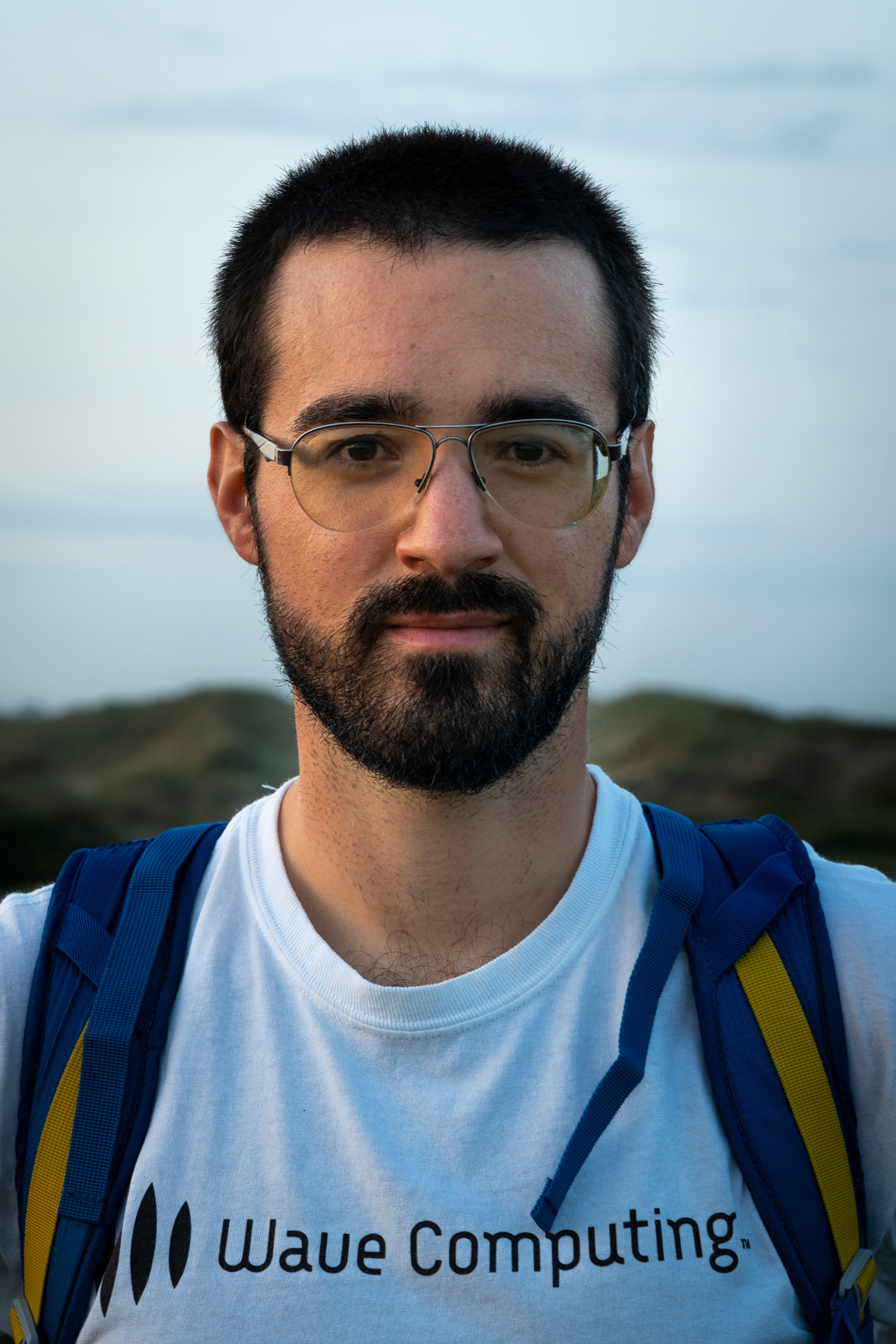 I
met Marija in Petnica Science Center where she guided me through a year-long project
in computational plasma physics. As a part of the project, I have written a PIC simulation
from scratch in order to see how different laser parameters are going to impact the
energy of the final bunch. Throughout the project I’ve learned the basics of electromagnetism,
different numerical methods and the possibilities of a high performance computing
as well as how to present my work at conferences. Things that I learned doing the
project helped me later in my academic career. Currently I am a PhD student at Quantum
Matter Theory Group of Koenraad Schalm and Jan Zaanen in Lieden, Netherlands. My
current focus is on ways how highly correlated systems thermalise and the foundations
of quantum statistical physics.
I
met Marija in Petnica Science Center where she guided me through a year-long project
in computational plasma physics. As a part of the project, I have written a PIC simulation
from scratch in order to see how different laser parameters are going to impact the
energy of the final bunch. Throughout the project I’ve learned the basics of electromagnetism,
different numerical methods and the possibilities of a high performance computing
as well as how to present my work at conferences. Things that I learned doing the
project helped me later in my academic career. Currently I am a PhD student at Quantum
Matter Theory Group of Koenraad Schalm and Jan Zaanen in Lieden, Netherlands. My
current focus is on ways how highly correlated systems thermalise and the foundations
of quantum statistical physics.
Djordje Radicevic
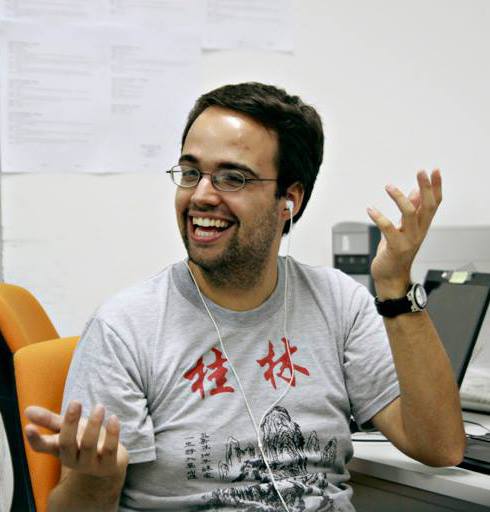 During my freshman year of high school, while attending a physics summer program
at the Petnica Research Center, I worked on a small research project under Marija's
supervision. The goal of the project was to apply the numerical method of simulated
annealing to finding equilibrium configurations of many charged particles confined
to a given geometry. This was my first foray into numerical methods as a tool in
physics: I learned to design and implement code, to look for relevant literature,
and to interpret results and identify numerical errors. Besides laying the foundation
for my interest in physics research in general (I am currently a postdoctoral fellow
at the Perimeter Institute for Theoretical Physics), this project has also taught
me a lot about Monte Carlo methods that are ubiquitous in many areas of physics.
I still find that the knowledge gained during this project is useful for understanding
current research of my fellow physicists.
During my freshman year of high school, while attending a physics summer program
at the Petnica Research Center, I worked on a small research project under Marija's
supervision. The goal of the project was to apply the numerical method of simulated
annealing to finding equilibrium configurations of many charged particles confined
to a given geometry. This was my first foray into numerical methods as a tool in
physics: I learned to design and implement code, to look for relevant literature,
and to interpret results and identify numerical errors. Besides laying the foundation
for my interest in physics research in general (I am currently a postdoctoral fellow
at the Perimeter Institute for Theoretical Physics), this project has also taught
me a lot about Monte Carlo methods that are ubiquitous in many areas of physics.
I still find that the knowledge gained during this project is useful for understanding
current research of my fellow physicists.
Bernhard Pruckner
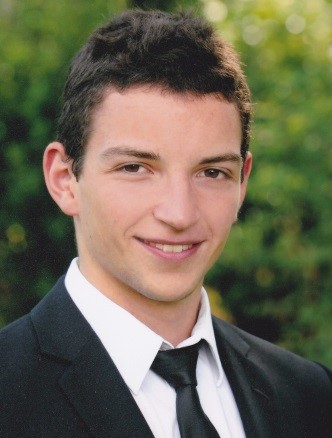 During my master’s degree program in Technical Physics at the TU Wien, I did a three-month
internship at Instituto Superior Técnico Lisboa. I had the chance to work on a research
project as a part of GoLP under the supervision of Marija Vranic. Marija introduced
me to the working methods in scientific research. This experience had a big influence
on my views on how I wanted my further studies at university and my career afterwards
to look like. For the first time I could work in a theoretical group, translating
physical models into code and conducting numerical simulations. I really enjoyed
this kind of work and decided that this is what I wanted to do further on. During
my time at GoLP, I was able to work with many dedicated scientists and with the profound
help of Marija, who was very supporting the whole time through, carry out a really
interesting and fun research project. I also had the chance to present my work at
my home university and work on a project there, an opportunity I got because of the
experiences gathered during my internship at GoLP.
During my master’s degree program in Technical Physics at the TU Wien, I did a three-month
internship at Instituto Superior Técnico Lisboa. I had the chance to work on a research
project as a part of GoLP under the supervision of Marija Vranic. Marija introduced
me to the working methods in scientific research. This experience had a big influence
on my views on how I wanted my further studies at university and my career afterwards
to look like. For the first time I could work in a theoretical group, translating
physical models into code and conducting numerical simulations. I really enjoyed
this kind of work and decided that this is what I wanted to do further on. During
my time at GoLP, I was able to work with many dedicated scientists and with the profound
help of Marija, who was very supporting the whole time through, carry out a really
interesting and fun research project. I also had the chance to present my work at
my home university and work on a project there, an opportunity I got because of the
experiences gathered during my internship at GoLP.
Manuel Blanco Fraga
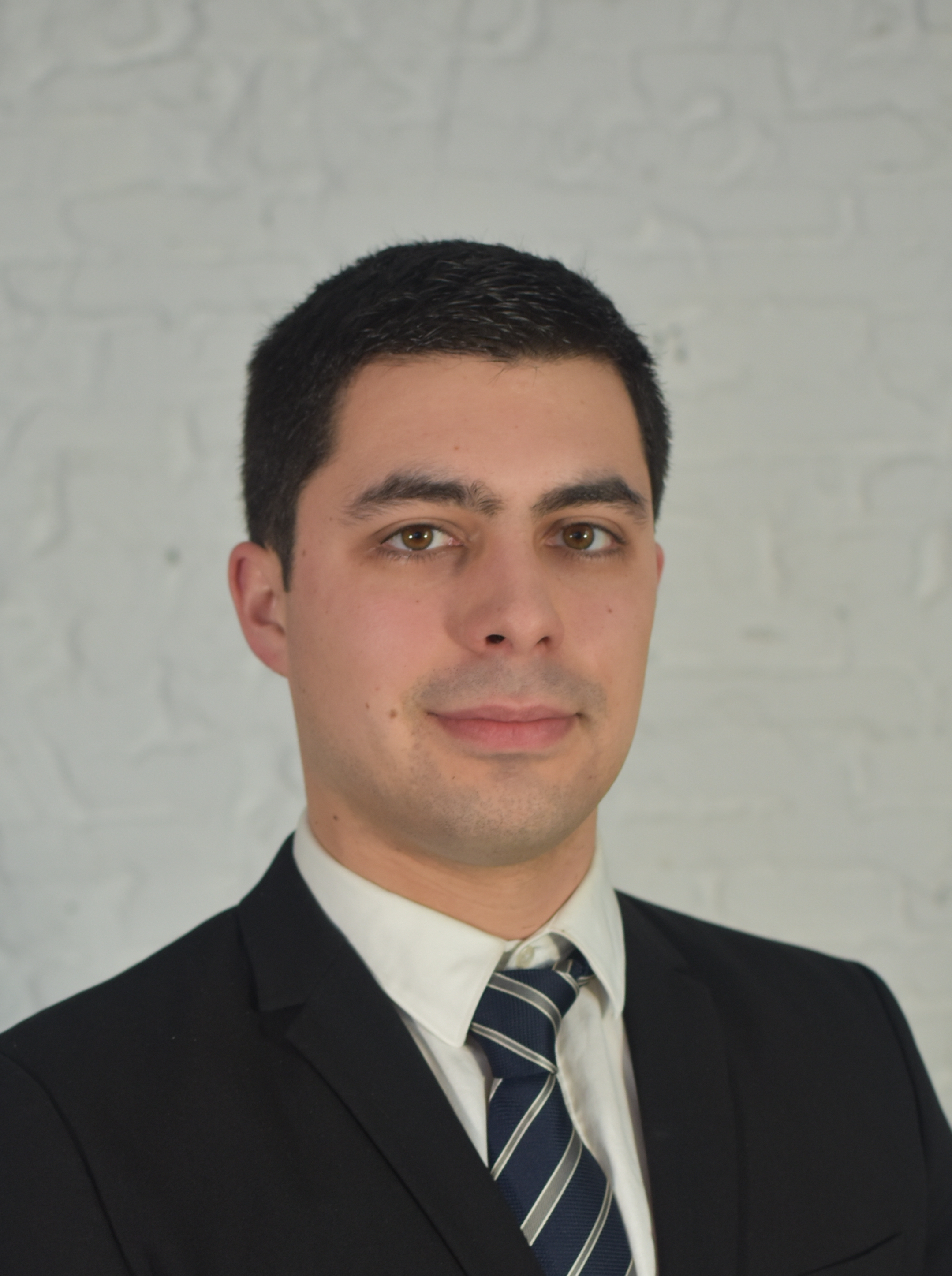 I
was a PhD student at the University of Santiago de Compostela. During my PhD studies
I spent three months in Lisbon, working on a research project that later on became
a relevant piece of my thesis. During that time I worked under the supervision of
Marija Vranic. The project consisted on assessing how nanostructures at the surface
of solid targets affected laser-powered proton acceleration caused by laserplasma
interaction. The research revealed that, by using triangular nanostructures, it was
possible to achieve nearly total energy absorption from the laser and to increase
proton energy substantially, being able to achieve energy on the tens of MeV by using
table-top laser sources. The work was published in the New Journal of Physics.
I
was a PhD student at the University of Santiago de Compostela. During my PhD studies
I spent three months in Lisbon, working on a research project that later on became
a relevant piece of my thesis. During that time I worked under the supervision of
Marija Vranic. The project consisted on assessing how nanostructures at the surface
of solid targets affected laser-powered proton acceleration caused by laserplasma
interaction. The research revealed that, by using triangular nanostructures, it was
possible to achieve nearly total energy absorption from the laser and to increase
proton energy substantially, being able to achieve energy on the tens of MeV by using
table-top laser sources. The work was published in the New Journal of Physics.
Martin Jirka
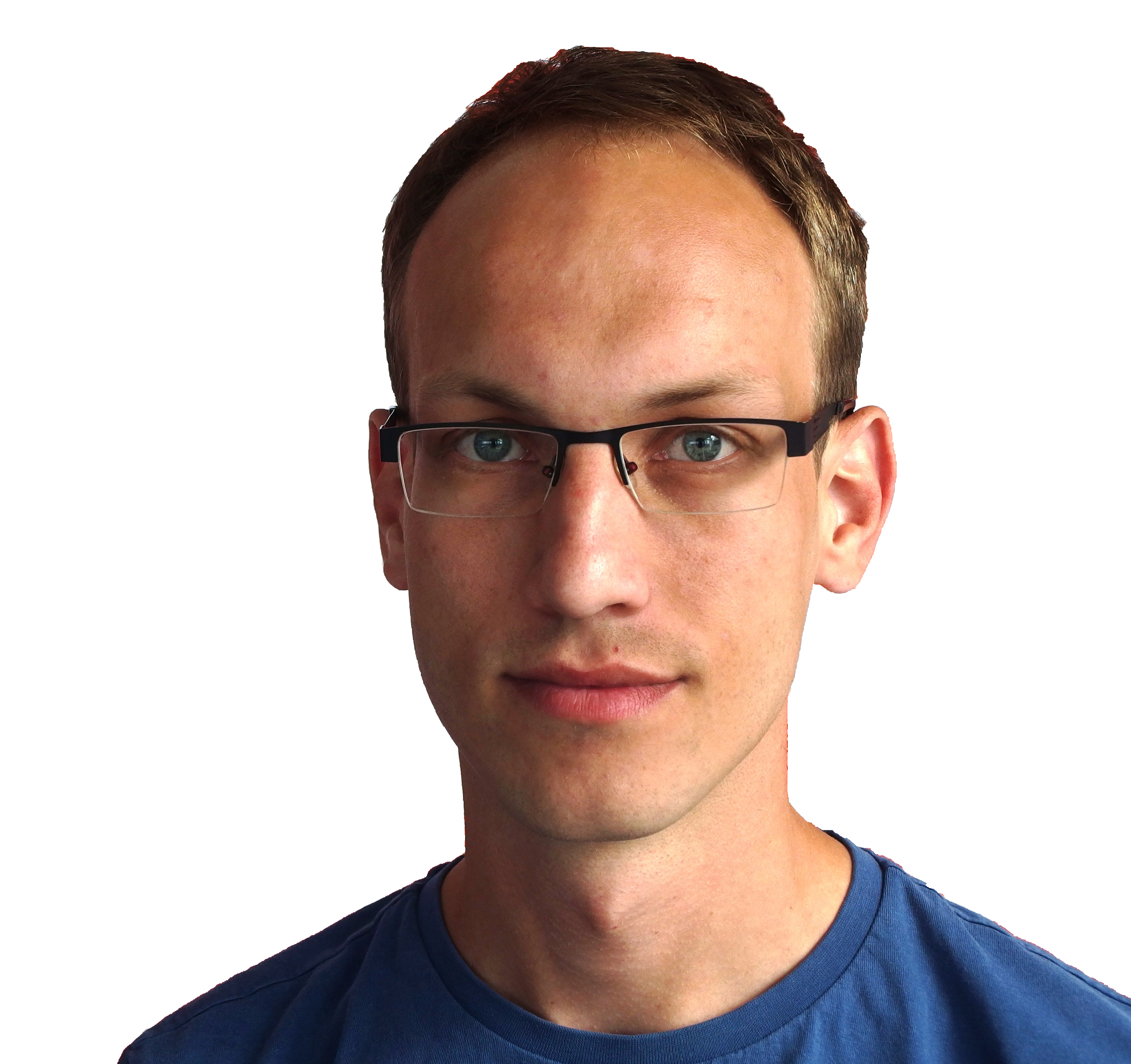 I
was a PhD student at the Technical University of Prague. I have spent half a year
during my PhD at the Instituto Superior Técnico (IST) in Lisbon in the Group for
Lasers and Plasmas (GoLP). As it was my last year in PhD course, I was eager to further
my knowledge in ultra-intense laser-plasma interactions and to widen my horizons
beyond the topic of my dissertation. I have therefore arranged an internship in GoLP
at IST, where I worked under the supervision of Dr. Marija Vranic. She provided me
with a new topic that I started to work on. Under her supervision, I learnt a lot
not only about physics of laser-matter interactions, but also about advanced computing
and theoretical modelling of such interactions. I appreciate her guidance that provided
me just enough freedom to make my own mistakes from which I can learn while the course
of the work has still been closely supervised and safely guided."
I
was a PhD student at the Technical University of Prague. I have spent half a year
during my PhD at the Instituto Superior Técnico (IST) in Lisbon in the Group for
Lasers and Plasmas (GoLP). As it was my last year in PhD course, I was eager to further
my knowledge in ultra-intense laser-plasma interactions and to widen my horizons
beyond the topic of my dissertation. I have therefore arranged an internship in GoLP
at IST, where I worked under the supervision of Dr. Marija Vranic. She provided me
with a new topic that I started to work on. Under her supervision, I learnt a lot
not only about physics of laser-matter interactions, but also about advanced computing
and theoretical modelling of such interactions. I appreciate her guidance that provided
me just enough freedom to make my own mistakes from which I can learn while the course
of the work has still been closely supervised and safely guided."
